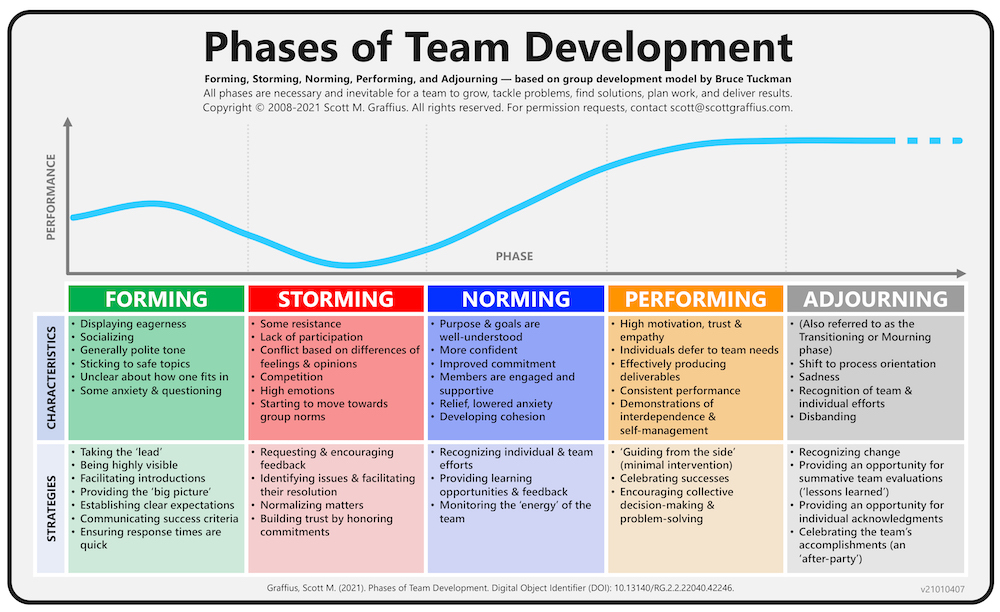In the dynamic and often high-stakes world of construction management, effective teamwork is a critical component for project success. Construction projects, by their nature, involve a diverse array of professionals including architects, engineers, project managers, contractors, and laborers, all of whom must work in unison to deliver a project on time, within budget, and to the required quality standards. Understanding and managing team dynamics is thus essential. Bruce Tuckman’s team development model, first proposed in 1965, provides a valuable framework for understanding and guiding teams through the stages of development. This model outlines five stages: Forming, Storming, Norming, Performing, and Adjourning. Each stage plays a vital role in building a cohesive, productive team capable of tackling the complex challenges inherent in construction management.
Forming: Laying the Foundations
The initial stage, Forming, is characterized by a sense of anticipation and uncertainty as team members first come together. In construction management, this stage involves assembling a team from various disciplines and introducing them to the project goals, roles, and expectations. Team members are often polite and reserved as they get to know one another and understand their place within the group.
During the Forming stage, the construction manager’s role is crucial. They must provide clear direction and establish the groundwork for team cohesion. This involves:
- Defining Objectives: Clearly articulating the project’s goals, timelines, and deliverables.
- Clarifying Roles: Ensuring each team member understands their specific responsibilities and how their work integrates with the overall project.
- Establishing Communication Channels: Setting up effective communication systems to facilitate the free flow of information among team members.
- Building Trust: Creating an environment where team members feel valued and trusted, encouraging openness and collaboration from the outset.
The primary challenge in this stage is overcoming the initial discomfort and uncertainty. Team-building activities and workshops can be beneficial, allowing team members to develop relationships and build trust.
Storming: Navigating Conflict
The Storming stage is often the most challenging phase of team development. As team members begin to assert their ideas and perspectives, conflicts and power struggles may emerge. In the context of construction management, this stage can be marked by disagreements over design choices, resource allocation, and project methodologies.
Effective conflict management is crucial during Storming. The construction manager must:
- Facilitate Open Dialogue: Encourage team members to voice their concerns and ideas openly and constructively.
- Mediate Conflicts: Act as a mediator to resolve disputes and find common ground, ensuring that conflicts do not derail the project.
- Reinforce Goals: Continuously remind the team of the project objectives and the importance of working collaboratively to achieve them.
- Encourage Empathy: Promote understanding and empathy among team members, helping them appreciate diverse viewpoints and expertise.
Storming, while difficult, is a necessary phase where critical issues are addressed, and team members learn to navigate differences, ultimately leading to stronger collaboration.

Norming: Establishing Norms and Cohesion
In the Norming stage, the team begins to develop a sense of cohesion and unity. Team members have resolved many of their differences, established norms for working together, and are more comfortable with their roles and each other. This stage is characterized by increased cooperation, trust, and a focus on common goals.
For construction managers, fostering this sense of unity involves:
- Strengthening Relationships: Encouraging social interactions and team-building activities that reinforce relationships and trust.
- Standardizing Processes: Implementing standard procedures and workflows to ensure consistency and efficiency in project execution.
- Promoting Accountability: Ensuring that team members are accountable for their tasks and supportive of one another’s success.
- Celebrating Milestones: Recognizing and celebrating achievements and milestones to build morale and motivation.
The Norming stage is crucial for establishing a productive working environment where team members are aligned and committed to the project’s success.
Performing: Achieving Peak Efficiency
In the Performing stage, the team reaches a level of maturity and functionality where they can work together seamlessly to achieve project goals. Team members are highly motivated, self-reliant, and capable of making decisions collaboratively. The focus is on high performance and the efficient delivery of the project.
For construction managers, this stage involves:
- Delegating Effectively: Trusting team members to take ownership of their tasks and make decisions within their areas of expertise.
- Facilitating Innovation: Encouraging creative problem-solving and innovation to overcome challenges and improve processes.
- Monitoring Progress: Continuously tracking project progress and addressing any issues promptly to keep the project on track.
- Supporting Development: Providing opportunities for professional growth and development to keep the team engaged and motivated.
During the Performing stage, the construction manager’s role shifts from directive to supportive, allowing the team to operate at its full potential.
Adjourning: Dissolution and Reflection
The final stage, Adjourning, involves the dissolution of the team as the project comes to an end. This stage is characterized by a mix of emotions as team members reflect on their achievements and prepare to move on to new projects.
For construction managers, the Adjourning stage involves:
- Conducting Reviews: Holding post-project reviews to assess what went well and what could be improved in future projects.
- Acknowledging Contributions: Recognizing and appreciating the contributions of each team member to reinforce their value and build positive relationships for future collaborations.
- Providing Closure: Ensuring a sense of closure for the team, helping them transition smoothly to their next roles or projects.
- Documenting Lessons Learned: Capturing insights and lessons learned to inform future projects and improve overall team performance.

Conclusion
Bruce Tuckman’s team development model provides a comprehensive framework for understanding and managing team dynamics in construction management. By guiding teams through the stages of Forming, Storming, Norming, Performing, and Adjourning, construction managers can foster a collaborative, high-performing team capable of delivering complex projects successfully. Each stage presents unique challenges and opportunities, requiring careful management and a deep understanding of team dynamics. Ultimately, the ability to effectively navigate these stages is a key determinant of project success in the construction industry.





